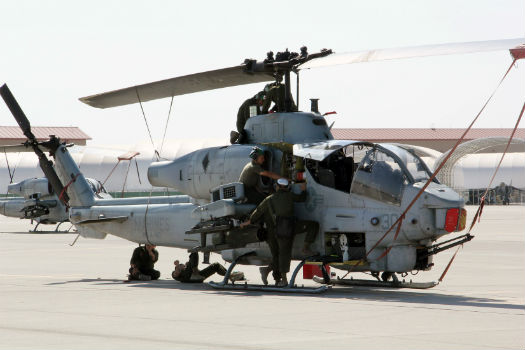
Aircraft mechanic Marines with Marine Aviation Weapons and Tactics Squadron 1 inspect an AH-1W Super Cobra helicopter during a routine maintenance inspection Weapons and Tactics Instructor course 2-15 aboard Marine Corps Air Station Yuma, Ariz., April 22. U.S. Marine Corps/Sgt. Cody Haas Photo
More than 80 pilots arrived in late March for Weapons and Tactics Instructor course 2-15 in hopes of earning their certifications as weapons and tactics instructors before departing the seven-week course aboard Marine Corps Air Station Yuma, Ariz. With them, approximately 85 aircraft from squadrons across the Marine Corps arrived in support of the course, sponsored by Marine Air Weapons and Tactics Squadron 1.
To keep that many aircraft in the sky, it requires more than 1,000 maintainers to augment to MAWTS-1 to meet the demand of operations. All Marine Corps aircraft require a specific number of maintenance hours for every flight hour. To meet this, Marines have put in 18,500 maintenance hours for helicopters such as the CH-53E Super Stallion helicopter, MV-22 Osprey, AH-1W Super Cobra, AH-1Z Viper Super Cobra, UH-1Y Venom helicopter and more than 8,200 hours of maintenance for the AV-8B Harrier II ground attack aircraft and F/A-18 Hornet.
“Our mission is to maintain and fix aircraft to accommodate students during the daily flight schedule,” said Master Gunnery Sgt. William Lloyd, the maintenance chief for MAWTS-1. “Depending on the evolution there can be over 60 aircraft operating at one time,” said Lloyd. “These types of aircraft operated more than 8,000 flight hours in multiple training scenarios during the last class.”
Marines who augment to MAWTS-1 meticulously perform every maintenance procedure, leaving almost no margin for error. The pilots in the air rely on the expertise of the maintainers to ensure that each aircraft functions as it is supposed to.
“Any lapse in attention to detail can result in an aircraft mishap,” said Lloyd. “I cannot over emphasize the importance of ensuring that every component and fastener is where it is supposed to be.”
During the seven-week course maintainers play a crucial role in assisting the candidate pilots in accomplishing their goal to become certified WTIs. As WTIs, they will return to their fleet units to serve in key training officer billets, ensuring Marine aviation units continue to train to the same standard across the Corps. Courses like WTI ensure the Marine Corps continues to serve as the nation’s force in readiness.









